Baby Steps
If you’ve never done a “brick” workout, it’s hard to relate to the difficulty of running after riding a bike for an extended period of time. A brick is practicing the transition from one discipline to another, usually, bike to run. But, why is it so hard to run after cycling? In large part, there are two physiological reasons:
- While cycling the vast majority of blood is directed to your quadriceps. That “pooling” in the quads remains when you get off the bike. Your legs feel like slabs of meat until the blood redistributes to the additional muscles needed to support running (hamstrings and calves).
- If you are pushing hard on the bike for an extended period of time, your brain adapts and sends signals to your legs that say “pedal in circles”. Then, in a minute or so, you suddenly ask your body to stop that and do something completely different (start running).
I’m told, and I keep reading that the transition from cycling to running gets easier with practice. Well folks, exactly how much practice do I need before I feel the difference?
As I described in my previous post, I struggled greatly in transition 2 (T2) going from cycling to running.
The instructions Johnny (my coach) gave were to take short quick steps initially. Basically, scoot & shuffle until I got the feeling in my legs again.
As I walked the bike back to the rack I did my best to prevent my hamstrings from cramping up. Every time I picked my leg up I could feel the muscle on the verge of seizing. That was the last thing I wanted to deal with while I ran. Another unexpected challenge was simple stability while I walked. The bike shoes are hard plastic so they don’t flex like normal shoes. Wearing stiffer shoes requires increased lower leg muscle engagement to maintain stability while walking. My calves and other lower leg muscles were a wreck. They were barely helping me walk and I just knew that I was going to fall over and drop my bike in a big, spectacular crash. Fortunately, I was able to make it back to my spot in the transition area without incident.
I was totally focused on getting moving. I did everything that I could to change my shoes without causing my calves or hamstrings any stress. I took a few extra seconds while I was on the ground to just stretch with my legs. I was fully aware of how it would delay my exit, but it just felt like a necessary thing to do at the time. Maybe just getting up and walking or running would have loosened the muscles too. I really don’t know. I don’t have that experience so I went with what seemed best in the moment.
Another big rookie mistake that I made was to not take fluids on my ride and I ended up being terribly thirsty towards the latter end of it. I had pre-filled a water bottle with an hydration solution (similar to Gatorade or PowerAid). Unfortunately, I added too much of the mix to the water. This probably contributed to my nausea earlier in the day. As I packed up in the morning I added my Isagenix AMPED Hydrate packet that I normally use during my training sessions. I also added the fruit punch flavored mix that was included in my race packet. I figured, why not? It might taste better and give me even more energy. You know, if one is good, two is better.
Since I wasn’t sure if that “master mix” of hydration supplements was the cause of my nausea, I was reluctant to sip from that bottle again. I needed regular water or gatorade badly. I was excited to see a water station right at the beginning of the running trail! I drank three cups of water, and Gatorade.
Once I began trying to run, shuffle really, I focused on my form and keeping my mind on running to the finish line. Nothing else. I’ve read many articles about getting through the mental and physical challenges during distance runs and one common technique is to stay present at the moment. Runners have mental tricks they use to stay present and to reduce their minds from wandering or from going negative. I haven’t tried to develop anything like that. I have been working on keeping my mind on my form and my breathing. Then I keep an eye on my pace. I’ve developed a feel for what pace is manageable for me to run 4 to 5 miles. I wasn’t sure if it would still be manageable after a swim-bike combo, at-least I had a reference point.
I was only able to bring myself to run-walk for the first .75 miles. It was extraordinarily difficult to maintain the run. My legs were loosening up a little but were still heavy. Then, at about 1.25 miles, the discomfort and weightiness disappeared. Just like that, it was gone. I was able to run comfortably. I was still fatigued, but not so much that running was laborious. I was suddenly feeling encouraged and more excited about finishing strong.
With the newly found energy, I picked up the pace and started to enjoy the scenery and the weather. My form felt good although I knew that I was not running fast. I was running slower than 10 min/mile which is not even remotely competitive. I made sure to grab cups of fluid at each hydration station (there was one station at each mile). Occasionally, I would place my sights on a runner who was ahead of me and try to close the gap (or not let the gap widen). This served to keep me focused and at the very least, keep my pace.
As I rounded the last turn and came into the final 3/4 mile stretch, I began to feel the fatigue again. I was determined to run it strong. So, I picked up my feet and shut off the “just walk for a little bit” whispering part of my mind. It was hard. At one point, it felt like the scene in Poltergeist where the mom was walking down the hallway that just kept getting longer. Someone was moving the finish line. Then, I saw my son. I knew he was planning to run the last bit to the finish line with me. That has been his tradition since he was a little boy. I was filled with energy again. I gave him a fist bump and we sprinted to the finish line.
I did notice that although I was tired I wasn’t completely exhausted. That’s a HUGE improvement from my previous two sprint races. My time was a bit better this time, but I felt a lot better at the finish which told me that my physical conditioning is improving. More importantly, it meant that I can push harder and make to the end. It’s a matter of getting comfortable racing at a higher intensity.
Race Results
My individual times (see image below):
- 12:58 – 500m Swim – an average of 2:03 per 100 yards.
- 55:23 – 14 Mile Bike – average 14.1 MPH
- 35.56 – 5K Run – average 10:52 min per mile
The overall results of the Sprint Age Group racers (how my times compare to the others):
- I placed 117 of 134 overall
- I placed 12 of 14 in my age group – not last, but almost last. This must improve…
- I placed 70 of 76 in my gender
What does it all mean
I find reflection and analysis of the lessons from each race and training session important. The race is where all of my training is combined and executed. It is during the race that the holes are exposed. The weaknesses and the strengths in my conditioning are experienced. The way I will improve is honestly acknowledging the pros and the cons of race performance and use that data to improve my training sessions. I’ve summarized many of the lessons below.
- Don’t try new nutrition/hydration on race day. Experiment with this during training. Find what works best and execute the same during the race. Make further adjustments during subsequent training days.
- Practice everything regardless of how easy it seems when you are training. During race day, the chaos changes the dynamics of your thinking and physical responses. Having everything imprinted as muscle memory is key. Stressful, unanticipated situations arise during a race. Automatically adjusting helps you adapt and continue with minimal delays or an impact on your performance. For example, rolling on my back during the swim.
- Know the course well in advance of the race. If there are hills, spend some time training for hills. Be aware of your physical response to the changes in terrain before you encounter them on the racecourse.
- Have a plan for each event and transition. Know before you go.
- Don’t forget your plan.
- Stay present and aware of your mind and body as you race. You’ll notice a lot of important things and you’ll enjoy the race more.
- Practice transitions
- Spend time learning how to eat and when to eat before a race.
- Sleep Sleep Sleep
- Talk to the other participants.
- Know your strengths. I started too far back in the swim because I lost my confidence. That choice cost me time and energy as I fought my way past slower swimmers.
- Don’t allow your mind to go negative when you are struggling. Acknowledge the difficulty, but know that you’ve trained for this and it will pass. Stay focused on the plan, not the pain.
- Have supporters present if possible. Enthusiasm is contagious and energizing. The warm, encouraging smile of a loved one is like a bottle of turbo boost. Everyone should have access to that.
- Stretch and warm-up before the race. Your muscles will reward you.
- I am completely unprepared to run a full Ironman race, but I can still see myself doing it. This short race is a great reference point.
- Talk about the race afterward with experienced racers & trainers. They will share a serious perspective and insight into your progress.



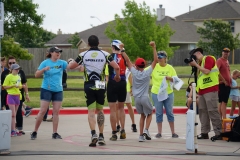

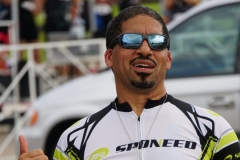
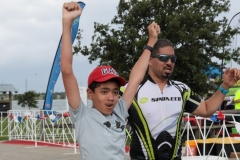
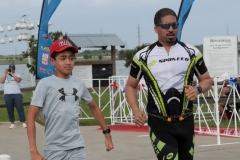
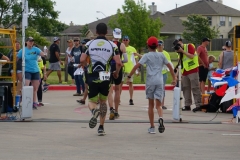





Trackbacks/Pingbacks